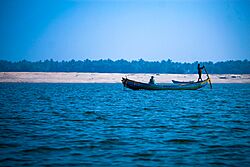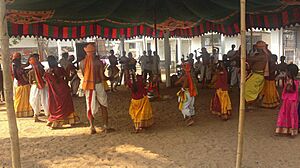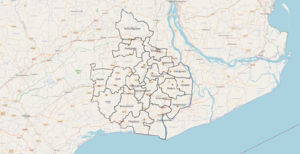West Godavari district facts for kids
The West Godavari district is a beautiful coastal area in the Indian state of Andhra Pradesh. Its main office, or headquarters, is in Bhimavaram. In 2011, the district covered about 2,178 square kilometers and had a population of 1,779,935 people.
The district is surrounded by the Krishna district and the Bay of Bengal to the south. To the east, you'll find the East Godavari district. The Eluru district, Kolleru Lake, and Upputeru Drain are to the northwest.
Quick facts for kids
West Godavari district
|
|
|---|---|
|
Clockwise from top-left: Paddy fields near Bhimavaram, Rachuru village, Ramalingeshwaraswamy Temple in Ksheerarama, Godavari at Achanta, Someshwara Swamy Temple
|
|
| Country | |
| State | Andhra Pradesh |
| Region | Coastal Andhra |
| Headquarters | Bhimavaram |
| Mandals | 20 |
| Area | |
| • Total | 2,278 km2 (880 sq mi) |
| Population
(2011)
|
|
| • Total | 1,844,898 |
| • Density | 809.88/km2 (2,097.6/sq mi) |
| • Urban | 468,924 |
| Demographics | |
| • Literacy | 74.63% |
| • Sex ratio | 1004 |
| PIN |
534201
|
| Vehicle registration | AP-37 (former) AP–39 (from 30 January 2019) |
| Major highways | NH-16,NH-165, NH-216, NH-216A, NH-365BB, NH-516D, NH-516E |
Contents
History of West Godavari
The area of coastal Andhra Pradesh was once ruled by the Eastern Chalukyas from 700 to 1200 CE. Their capital was in a place called Vengi. You can still find historical evidence of their rule in nearby villages like Pedavegi and Guntupalli.
Later, Eluru became part of the Kalinga Empire until 1471 CE. After that, the Gajapati Empire took control. In 1515 CE, a famous ruler named Sri Krishna Deva Raya captured it.
After the Vijayanagara Kingdom fell, the area was ruled by the Sultans of Golkonda from the Qutb Shahi Dynasty.
How the District Was Formed
On April 15, 1925, the West Godavari District was officially created. Its headquarters were first in Eluru, where all the main district offices were located.
During the time of the Madras Presidency in 1823, the District of Rajahmundry was formed. It was later reorganized in 1859 and split into the Godavari and Krishna districts.
Under British rule, Rajahmundry was the main city for the Godavari district. In 1925, the Godavari district was further divided into East Godavari and West Godavari districts. When this happened, Kakinada became the headquarters for East Godavari, and Eluru became the headquarters for West Godavari.
More recently, on April 4, 2022, the district was split again to create a separate Eluru district. Because of this, Bhimavaram became the new headquarters for the West Godavari district.
Geography and Rivers
The West Godavari district covers an area of about 7,742 square kilometers. It is bordered by the East Godavari district to the north and the Eluru district to the northwest. To the southeast, you'll find the Dr. B. R. Ambedkar Konaseema district, and to the southwest, the Krishna district. The Bay of Bengal is to the south.
The mighty Godavari River flows on the east side of the district. The Tammileru River and Kolleru Lake separate it from the Krishna district on the west.
Rivers and Land
West Godavari is mostly a flat area. It has a gentle slope that follows the rivers as they flow eastward. The three main rivers that cross the district are the Godavari, the Yerrakaluva, and the Tammileru.
Important sources of water for farming include the Sir Arthur Cotton Barrage, Eluru Canal, Vijayarai Anicut, Tammileru, Jalleru, and the Yerrakaluva reservoirs. These help irrigate the land.
Climate in West Godavari
The district has a tropical climate, just like other parts of the Coastal Andhra region. Summers, from March to June, are very hot and dry. Temperatures can often go above 40 degrees Celsius during the day.
Winters are much cooler and more pleasant. The rainy season, from July to December, is a great time to visit. During this time, the fields are bright green with paddy crops, and the rivers are full from the monsoon rains. The weather is also cooler.
People and Population
As of the 2011 Census of India, the West Godavari district had a population of 3,936,966 people living in 1,091,525 homes. This made it the 11th most populated district in the state at that time. The district's population was roughly similar to the country of Croatia or the American state of Oklahoma.
Before the district was split, it was the 19th largest in Andhra Pradesh by area. It had a population density of 509 people per square kilometer, making it the fourth most densely populated district in the state. The population grew by 3.45% between 2001 and 2011.
West Godavari has a sex ratio of 1004 females for every 1000 males, ranking eighth in the state. It also has the highest literacy rate among all Andhra Pradesh districts, with 74.63% of its residents being able to read and write. About 20.6% of the district's population lives in cities.
| Religions in West Godavari district (2011) | ||||
|---|---|---|---|---|
| Religion | Percent | |||
| Hindus | 94.47% | |||
| Christians | 3.83% | |||
| Muslims | 1.49% | |||
| Other or not stated | 0.21% | |||
| Distribution of religions | ||||
After the district was split, the new West Godavari district had a population of 1,779,935. The sex ratio was 1002 females for every 1000 males. About 26.35% of the people live in urban areas. Telugu is the main language spoken by 98.67% of the people.
Economy and Industries
The total value of goods and services produced in the district, called the gross district domestic product, is about 45,963 crore Indian Rupees. This contributes 8.8% to the total gross state domestic product of Andhra Pradesh. In 2013–14, the average income per person was 86,974 Indian Rupees.
Main Agricultural Products
Paddy, banana, sugarcane, and coconut are the most important crops grown in the district. The farming sector contributes a large amount to the district's economy. Other important farm products include milk, meat, and fisheries.
Cashew nut, mango, and tobacco are also important crops. The district is also known for Shrimp production and fish farming.
Other Industries
The woolen pile carpet industry in Eluru is famous for making eco-friendly carpets from wool that is brought in from other places. Other important parts of the economy include construction, electricity, manufacturing, local trade, and transport.
Culture and Traditions
Telugu is the most widely spoken language in West Godavari. The Vedas, which are ancient sacred texts with an oral tradition recognized by UNESCO, are taught at the Sri Venkateswara Veda Patasala in Bhimavaram village. The district is also well known for its beautiful wool-pile carpets and products made by hand.
Tourist Spots and Landmarks
Eluru is the largest city in the district. It has many important places related to Buddhists and archeology. One such place is the Guntupalli Caves, which is considered one of the top 30 heritage sites in India. Eluru also has a tall 74-foot Buddha statue in the center of the city.
Some religious places to visit include Dwaraka Tirumala, also known as Chinna Tirumala (Little Tirumala). There is also the Veerabhadra Temple, Pattiseema, and the Pancharama Kshetras of Palakollu and Bhimavaram.
Other popular tourist spots are Perupalem Beach at Narasapuram, and Kolleru Lake. Kolleru Lake is the largest freshwater lake in India and a bird sanctuary. You can also visit the Sir Arthur Cotton Barrage and Havelock Bridge.
The government of Andhra Pradesh is working to make Rajahmundry Airport an international airport. This will help boost tourism, including helicopter tours over the Godavari districts. The Polavaram Project irrigation system is also expected to become a new tourist attraction.
Government and Administration
The West Godavari district has one parliamentary area and seven assembly areas. The parliamentary area is Narasapuram (Lok Sabha constituency).
Assembly Areas
The Narasapuram Lok Sabha constituency includes the following areas for the Legislative Assembly:
| Constituency number | Name | Reserved for (SC/ST/None) |
Parliament |
|---|---|---|---|
| 56 | Achanta | None | Narasapuram |
| 57 | Palakollu | None | |
| 58 | Narasapuram | None | |
| 59 | Bhimavaram | None | |
| 60 | Undi | None | |
| 61 | Tanuku | None | |
| 62 | Tadepalligudem | None |
Administrative Divisions
The new West Godavari district is divided into three main revenue divisions: Bhimavaram, Tadepalligudem, and Narasapuram. These divisions then split the district into 20 smaller areas called mandals.
These 20 mandals contain 296 Revenue villages and 6 municipalities. The municipalities are Narasapuram, Palakollu, Tadepalligudem, Tanuku, Bhimavaram, and Akiveedu.
- Bhimavaram revenue division
- Bhimavaram
- Veeravasaram
- Palakoderu
- Kalla
- Undi
- Akiveedu
- Ganapavaram
- Narasapuram revenue division
- Naraspuram
- Penugonda
- Palakollu
- Poduru
- Achanta
- Yelamanchili
- Mogalthur
- Penumantra
- Tadepalligudem revenue division
- Tadepalligudem
- Pentapadu
- Attili
- Iragavaram
- Tanuku
Cities and Towns
|
Largest cities or towns in West Godavari District
As per the 2011 Census |
||
|---|---|---|
| Rank | Pop. | |
| 1 | Bhimavaram | 146,961 |
| 2 | Tadepalligudem | 130,348 |
| 3 | Palakollu | 104,216 |
| 4 | Tanuku | 77,962 |
| 5 | Narasapuram | 58,780 |
| 6 | Akiveedu | 38,597 |
| 7 | [[{{{city_7}}}]] | {{{pop_7}}} |
| 8 | [[{{{city_8}}}]] | {{{pop_8}}} |
| 9 | [[{{{city_9}}}]] | {{{pop_9}}} |
| 10 | [[{{{city_10}}}]] | {{{pop_10}}} |
| S.No. | Municipal Body | Civic Status of town | No. of
wards |
Municipality
Formation Year |
2011 Census
Population |
2001 Census
Population |
1991 Census
Population |
1981 Census
Population |
1971 Census
Population |
1961 Census
Population |
1951 Census
Populations |
|---|---|---|---|---|---|---|---|---|---|---|---|
| 1 | Bhimavaram | Municipality Grade - Selection | 39 | 1948 | 1,46,961 | 1,42,064 | 1,21,314 | 1,01,894 | 63,762 | 43,821 | 30,928 |
| 2 | Tadepalligudem | Municipality Grade - Selection | 40 | 1958 | 1,04,032 | 1,02,622 | 88,878 | 62,574 | 43,610 | 27,086 | 13,543 |
| 3 | Palakollu | Municipality Grade - 1 | 35 | 1919 | 81,199 | 76,308 | 56,969 | 46,146 | 36,196 | 28,481 | 23,037 |
| 4 | Tanuku | Municipality Grade - 1 | 34 | 1979 | 77,962 | 72,970 | 62,913 | 53,618 | 34,197 | 24,657 | 16,906 |
| 5 | Narsapuram | Municipality Grade - 1 | 31 | 1956 | 58,770 | 58,604 | 56,362 | 46,033 | 36,147 | 30,064 | 20,999 |
| 6 | Akiveedu | Nagar Panchayat | 20 | 2020 | 36,000 | 24,259 | 29,421 | 21,317 | 16,880 | -- | 10,307 |
Transportation in the District
West Godavari has a good transportation network, including roads, railways, and waterways.
Roadways
The district has about 1,229 kilometers of state highways. Most people use public transport, especially buses run by the Andhra Pradesh State Road Transport Corporation. Major national highways, like NH216 and NH165, pass through many towns in the district.
Railways
The South Central Railway division of Indian Railways operates many passenger and freight trains here. The main railway lines are the Howrah-Chennai main line, the Vijayawada–Nidadavolu loop line, and the Bhimavaram–Narasapuram branch line. These lines connect different parts of the district by rail. There are also important railway projects like the Kovvur-Bhadrachalam line and the Kotipalli-Narsapur line.
Waterways
National Waterway 4 goes through the district. It connects Puducherry with Kakinada and Rajahmundry, passing through Tadepalligudem and Eluru. The district can access the Bay of Bengal at Narsapuram. In September 2021, the Andhra Pradesh state government started building a fishing harbor in Narsapuram.
Education and Learning
Schools for primary and secondary education are managed by the government's School Education Department. There are also many private schools. In the 2015–16 school year, there were 4,408 schools in total. This included government schools, local schools (mandal and zilla parishads), residential schools, private schools, Kasturba Gandhi Balika Vidyalaya (KGBV) schools, municipal schools, and other types of schools. During that year, 522,793 students were enrolled in primary, upper primary, and high schools in the district.
Universities in the District
- National Institute of Technology, Tadepalligudem (NIT, Tadepalligudem)
- Dr. Y.S.R. Horticultural University, Venkataramannagudem, Tadepalligudem
Famous People from West Godavari
Many notable people come from the West Godavari district, including:
- Brahmaji, a film actor
- Chiranjeevi, a film actor and former Central Minister
- Arvind Krishna, the CEO of IBM
- Raju Peddada, an industrial and graphic designer
- Prabhas, an actor
- Alluri Sitarama Raju, a brave freedom fighter
- Krishnam Raju, a film actor and former Central Minister
- Trivikram Srinivas, a film director
- Sunil (actor), an actor
- Krishna Vamsi, a film director
- Bhupathi Raju Srinivasa Varma, a Central Minister
See also
 In Spanish: Distrito de Godavari Oeste para niños
In Spanish: Distrito de Godavari Oeste para niños









